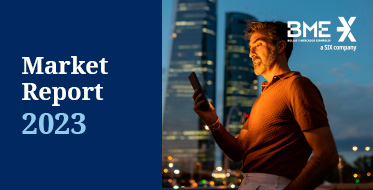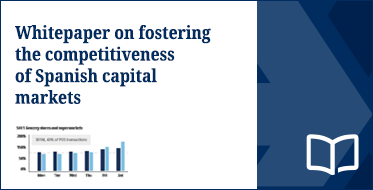MARF’s issuers contribute a turnover of 78 billion euros to the Spanish economy

- The study reveals that the non-financial companies that rely on this market for funding maintain 380,000 jobs and generate income worth 21 billion euros
- All sectors are represented in the market: 40% belong to the heavy industry and energy, 36% to consumer goods and services and the remaining 24% to other activities
- Madrid (48% of the companies), the Basque Country (18%) and Catalonia (7%) are the regions with the largest presence in MARF
- The ICO's public-private collaboration through MARF is making it possible to channel financial aid to meet the liquidity needs faced by companies due to the pandemic
MARF's issuing companies contribute a turnover of 78 billion euros to the Spanish economy, according to the report presented today in the Madrid stock exchange: "MARF and its contribution to business growth", produced by María José Palacín and Carmen Pérez, professors of Finance at the University of Seville. Excluding financial institutions, these companies support 380,000 jobs and generate income of 21 billion euros. MARF’s accumulated issued volume so far this year stands at 4.7 million euros and its current financing capacity, measured in terms of outstanding balance, is 6 billion.
During the presentation of the report, the first on this BME market, Gonzalo Gómez Retuerto, General Manager of BME Renta Fija and MARF, highlighted the diversity that the market has achieved in its almost 8 years of life, with 100 issuing companies, all types of fixed income instruments and a broad sectorial and geographical distribution. He also valued its role as a mechanism for financing and supporting the growth of companies. "MARF has contributed to the growth and expansion of companies, but it has also been able to adapt to the urgent liquidity requirements brough about by the pandemic by channeling public financial aid," he said.
Rosario Casero, ICO's Head of General Business, stressed that Spanish state-owned bank ICO is fully committed to the process of diversifying business financing sources, especially for small and medium-sized companies. This is a process to which the development of MARF in recent years has contributed, as demonstrated by the study presented today. The ICO's contribution has focused on the launch of both investment products and the management of public guarantees through MARF, always under public-private collaboration schemes. Alternative financing to traditional bank credit is necessary for the companies’ growth process and, in a very special way, in the most difficult times, for debt issuers due to the pandemic’s economic impact.
During the presentation of the report, María José Palacín stated that "MARF has successfully fulfilled the purpose for which it was created at the end of 2013: to provide an accessible financing alternative for businesses that allows them to reduce their dependence on bank credit. In this respect, Domingo García Coto, Head of BME's Research Department, highlighted that more than 60 Spanish companies have accessed the markets for the first time through MARF. "Diversifying the structure of external financing by combining credit and listed debt instruments provides greater stability to companies and is associated with a higher volume of investment", he said.
Analysis of the issuing companies
According to the study, 24% of the issuing companies belong to the basic materials, industry and construction sector; 22% of the issuers belong to the consumer products and services sectors; and 16% to companies linked to oil and energy. Other listed companies include providers of financial services (10%), real estate services (9%) and technology and telecommunications (5%). In terms of the geographical distribution, of the 100 issuing companies, six are Portuguese, one Dutch and another one British. The Madrid region accounts for 48% of the companies headquartered in in Spain, followed by the Basque Country (18%) and Catalonia (7%).
It should also be noted that almost half of the non-financial issuing companies in MARF are over 20 years old, a third are between 10 and 20 years old and the remaining fifth are less than 10 years old. Of them 65% are large companies (more than 250 employees), while the remaining 35% are equally divided between medium-sized companies (50 to 250 employees) and small companies (less than 50). In terms of the distribution of their capital, 65% of the issuers are non-listed companies, which makes MARF their gateway to the capital markets. Another 31% are listed on the stock exchange and the remaining 4% on BME Growth.
Analysis of issues
MARF registers a broad range of issues, which are becoming increasingly sophisticated. Currently 45% of the outstanding balance is placed in commercial paper, 35% in bonds and the remaining 20% in securitisations and mortgage-backed products. Over the last few years, the market has featured Contingent Convertible Bonds (CoCos), two issues of covered bonds and 5 green or sustainable bond operations. In terms of maturity, there are project bonds with maturities exceeding 30 years and commercial paper with terms of only 3 days.
The report also highlights that once they come to market, a large number of companies come back some years later, under market conditions that have allowed them to lengthen the terms and reduce the yields offered, thus improving their financial structure. The average internal rate of return (IRR) has fallen from 7.50% to 3.85% since MARF started, seven and a half years ago. In value terms, 73% of issues are for less than 40 million euros.
Through these links you can access the complete report (in Spanish) and photos of the presentation.


